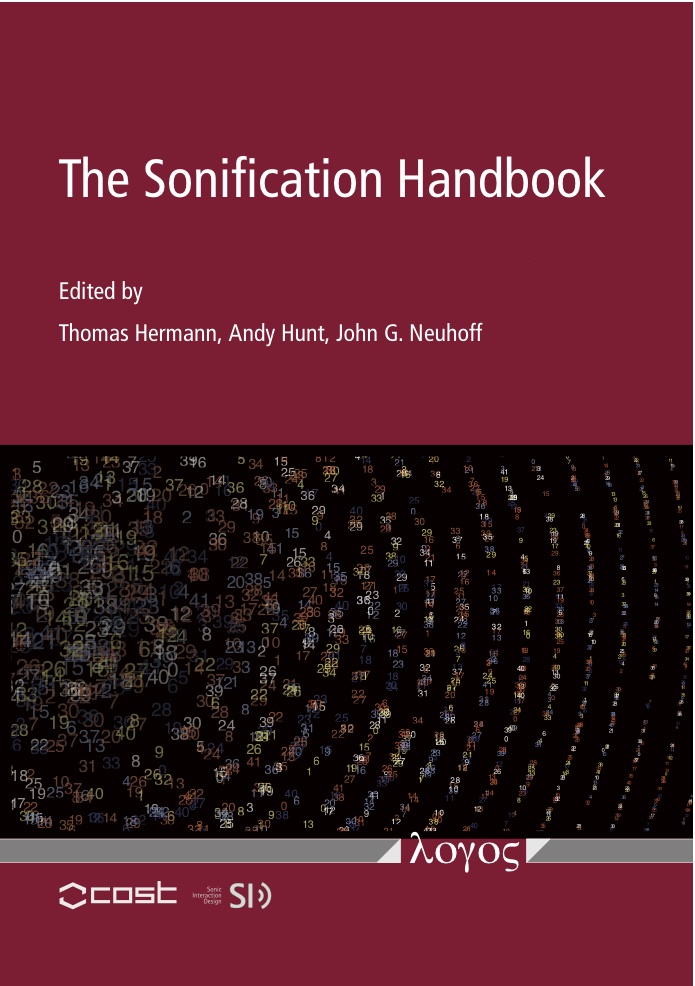Karmen Franinović, Stefania Serafin (eds.): Sonic Interaction Design (2013)
Filed under book | Tags: · acoustics, sonification, sound, sound design

“Sound is an integral part of every user experience but a neglected medium in design disciplines. Design of an artifact’s sonic qualities is often limited to the shaping of functional, representational, and signaling roles of sound. The interdisciplinary field of sonic interaction design (SID) challenges these prevalent approaches by considering sound as an active medium that can enable novel sensory and social experiences through interactive technologies. This book offers an overview of the emerging SID research, discussing theories, methods, and practices, with a focus on the multisensory aspects of sonic experience.
Sonic Interaction Design gathers contributions from scholars, artists, and designers working at the intersections of fields ranging from electronic music to cognitive science. They offer both theoretical considerations of key themes and case studies of products and systems created for such contexts as mobile music, sensorimotor learning, rehabilitation, and gaming. The goal is not only to extend the existing research and pedagogical approaches to SID but also to foster domains of practice for sound designers, architects, interaction designers, media artists, product designers, and urban planners. Taken together, the chapters provide a foundation for a still-emerging field, affording a new generation of designers a fresh perspective on interactive sound as a situated and multisensory experience.”
Contributors: Federico Avanzini, Gerold Baier, Stephen Barrass, Olivier Bau, Karin Bijsterveld, Roberto Bresin, Stephen Brewster, Jeremy Coopersotck, Amalia De Gotzen, Stefano Delle Monache, Cumhur Erkut, George Essl, Karmen Franinović, Bruno L. Giordano, Antti Jylhä, Thomas Hermann, Daniel Hug, Johan Kildal, Stefan Krebs, Anatole Lecuyer, Wendy Mackay, David Merrill, Roderick Murray-Smith, Sile O’Modhrain, Pietro Polotti, Hayes Raffle, Michal Rinott, Davide Rocchesso, Antonio Rodà, Christopher Salter, Zack Settel, Stefania Serafin, Simone Spagnol, Jean Sreng, Patrick Susini, Atau Tanaka, Yon Visell, Mike Wezniewski, John Williamson.
Publisher MIT Press, 2013
ISBN 0262018683, 9780262018685
376 pages
Thomas Hermann, Andy Hunt, John G. Neuhoff (eds.): The Sonification Handbook (2011)
Filed under book | Tags: · human-computer interaction, sonification, sound, sound design, technology

This book is a comprehensive introductory presentation of the key research areas in the interdisciplinary fields of sonification and auditory display. Chapters are written by leading experts, providing a wide-ranging coverage of the central issues, and can be read from start to finish, or dipped into as required (like a smorgasbord menu).
Sonification conveys information by using non-speech sounds. To listen to data as sound and noise can be a surprising new experience with diverse applications ranging from novel interfaces for visually impaired people to data analysis problems in many scientific fields.
This book gives a solid introduction to the field of auditory display, the techniques for sonification, suitable technologies for developing sonification algorithms, and the most promising application areas. The book is accompanied by an online repository of sound examples.
Publisher Logos Publishing House, Berlin, 2011
OpenAccess book
ISBN 9783832528195
586 pages
via xgz
PDF (single PDF)
PDF (PDF articles, with audio samples)
Stephen Travis Pope: Software Models and Frameworks for Sound Composition, Synthesis, and Analysis: The Siren, CSL, and MAK Music Languages (2005/2007)
Filed under book | Tags: · composition, computer music, music, performance, semantic analysis, sound design, sound recording, synthesis
Music is an undeniably complex phenomenon, so the design of abstract representations, formal models, and description languages for music-related data can be expected to be a rich domain. Music-making consists of a variety of diverse activities, and each of these presents different requirements for developers of new abstract and concrete data formats for musician users.
The topic of this anthology is the design of formal models and languages for a set of common musical activities including (but not limited to) composition, performance and production, and semantic analysis. The background of this work is the 50-year history of computer music programming languages, which began with low-level and (by today’s standards) simplistic notations for signal synthesis routines and compositional algorithms. Over these 50 years, many generations of new ideas have been applied to programming language design, and the topics of formal modeling and explicit knowledge representation have arisen and taken an important place in computer science, and thus in computer music.
The three concrete systems presented here have been developed and refined over a period of 25 years, and address the areas of (a) music composition (Siren), (b) sound synthesis and processing (CSL), and (c) music data analysis for information retrieval (MAK). In each successive generation of refinement of these concrete languages, the underlying models and metamodels have been considered and incrementally merged, so that the current-generation (Siren 7, CSL 4 and MAK 4) share both superficial and deep models and expressive facilities. This allows the user (assumed to be a composer, performer, or musicologist) to share data and functionality across these domains, and, as will be demonstrated, to extend the models and frameworks into new areas with relative ease.
The significant contributions of this work to the literature can be found in (a) the set of design criteria and trade-offs developed for music language developers, (b) the new object-oriented design patterns for computer music systems, and (c) the trans-disciplinary design of the three specific languages for composers, performer/producers, and musicologists presented here.
Anthology of papers by Stephen Travis Pope – 1986-2005; updated 2007
451 pages

